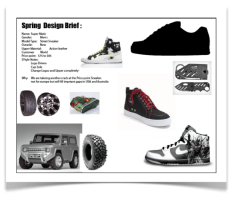The Shoe Design Brief
The Shoe Design Brief:
How does the shoe design process really work? Does a brilliant young shoe designer just create the new Adidas Power Boost shoe design out of thin air? Not really, our designer can’t do it all alone. Our brilliant young shoe designer is just one part of a team of professionals that may include the Product Line Manager (PLM), the Product Manager (PM), Footwear Developer, pattern maker and Engineer. The Design brief is the document the entire team will use to create the new shoe.
The footwear design brief is the instruction sheet and road map the product team will follow as they create the shoe. The design brief has information that each of our team members will need to get the job done right and to make the shoe a success. The design brief is often submitted to the company’s management for review before a project starts. With the manager’s approval, the design brief becomes a written record of the shoe development teams goals for the project.

A design brief for shoes can be a 1 page document, a 20 page report or pasted up concept board. The format I have used has the design brief broken down into two parts. The first part covering the price, demographics, competitors and technical details. The second part is the “Visual brief” and it can detail stylistic direction for the shoe.
So what questions should the shoe design brief answer? The answer is…it depends on the type of shoe you are working on. The running shoe design brief will be different from an army boot. So lets look at the basics.
What is the function of this shoe?
Running, Basketball, Snowboarding, Tennis or Skating
Do the shoe have a special feature?
thick midsole, thin midsole, fat tongue, no tongue etc.
Who is this shoe for?
Men, Women, a new Professional athlete, mall rats
What retail price is planned for the finished shoe?
Price point, Mid range, Deluxe or High end
When will it arrive in stores?
Spring , Summer, Winter, Fall or holiday selling seasons
What is the silhouette?
Ultra low, Low cut, Mid cut, High top
What is the target environment for this shoes?
Forest , Office, Desert, track, school, mountains?
What trends are up and coming?
Neon, earth tone , transparent, plaid
What countries will this shoe be sold in?
USA, Canada, China, Europe, Australia
What materials should be used?
High tech synthetic or classic leather
This there a competitor’s item doing well?
How many different color ways are required?
Is there something new technology your engineers are working on?
Is there a plan for import duty?
Are there existing outsole molds that can be or must be used?
Is there a particular new design element or material to try on this new shoe.
The Visual Design Brief
The visual brief will include photos of other shoes, cars, clothing or anything the PM thinks can help the footwear designer set the style or specific design details. In some cases if the shoe is for a pro athlete, you may be inspired by the athlete’s personal style or something they like.
This information should all be in the designer’s mind when pen hits the paper. First step the rough concept drawings. Just get the idea first. Once the design direction has been set the designer may create a CAD drawing to refine the concept.


